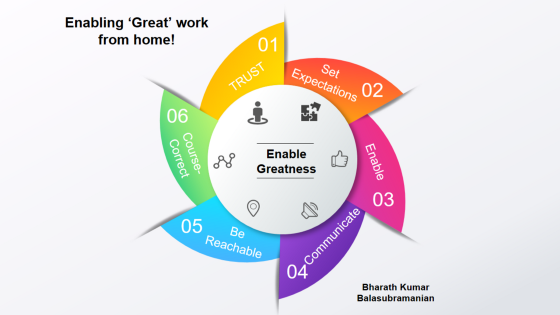We, as leaders, have to enable our teams — get ready for the magic!

Bharath Kumar BalasubramanianMar 12 · 4 min read
Working from home has never been needed as it is now with the Coronavirus spreading across the globe. Everyday, I hear news of more and more companies closing their offices and entire IT parks being evacuated. While we wait for this storm to tide over, we will have to ensure the safety of our teams, and along with it, our delivery and development plans.
Leadership qualities of ensuring direction, enabling productivity and demonstrating empathy are much needed in the current situation.
How can we, as leaders, enable and empower our teams to be effective from their homes?
Here are 6 things that have worked for me in the past:


- Trust:
Yes, Trust is the top item on my list.
You need to trust team members that they will do their best. I have seen and heard many leaders commenting on the lines of ‘Oh! That’s just extended holidays!’, ‘Long weekend got longer’, ‘He hardly performs at office, how will he do better at home?’ and so on. Very Insensitive.
You know why the folks don’t perform — they can sense and feel the lack of trust. Trust the team and the team will respond in ways that will leave you surprised!
Trust Fully — You can’t go wrong on this.
2. Set Clear Expectations:
A directionless team will spend a crazy amount of energy and team, but will reach nowhere. When we are co-located, it is easy to speak and work with one another so that the expectations are always clear. When working away, it is absolutely necessary that each individuals knows what is expected of them.
Clarify the bigger picture, show individuals how their parts fit in and help them understand the various touch-points with each other. Get the whole plan broken down into tasks and have an owner against each. Have the dependencies clearly marked out. This enables the team to work as a well-oiled machine, and with the minimum of supervision.
Great performing teams do not require supervision — they only need clarity of purpose and direction.
3. Enable your teams:
Be it having a machine to work on, or the necessary access to software (collaboration, ticketing, development environment), shared storage or even ensuring a high speed broadband — do your best to ensure the team is all set to perform. There is no fun in a developer having to call up a different team everytime he wants to deploy and test his code. That might work well when you are sitting next to each other in the office, but not when you are away. How can the number of unnecessary touch points be reduced?
If you want the teams to achieve flow, the roadblocks and distractions have to be eliminated.
4. Communicate:
Be in constant touch. You don’t go into hibernation mode once the tasks have been assigned. Set up a clear communication strategy. When will the daily meetings be held over a call/video conference. When do expect reports of progress. What to do in case of an Issue/Risk/Roadblock presenting itself. Using tools such as an Eisenhower matrix (urgent Vs, Important), Pareto list or scrum priority chart will ensure reporting happens on the needed basis. Use the amazing range of collaboration technology available today to bring everyone closer.
Encourage ‘Bad News First’ — and please do not shoot the messenger!
5. Be Reachable:
Sometimes, all your team members want is someone to be able to share issues with. They may know the solution themselves, but would still like a senior person to listen. It is the feeling of knowing that there is someone out there whom I can trust to help with my problems. It may not even be work related sometimes. All that matters sometimes, is that you listened! Do your best to alleviate the situation.
Trust is a 2-way street! Establish bonds.
6. Course-correct:
Ensure steady course-correction at all times. Your touch-points should not be discussing activities, rather the discussion should be focused on the goals to be achieved. Don’t get lost in the transactions — track if the team is, together, pushing forward on the bigger objectives. If there is an issue, then isolate the source and dig deeper. Course correction avoids last minute surprises and ensure that there is no wastage of time and effort ($).
Engage regularly and ensure that the team is tuned in on the bigger picture
Wishing you good luck!
I hope the productivity from home surpasses that of working out of an office!
